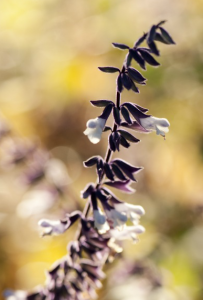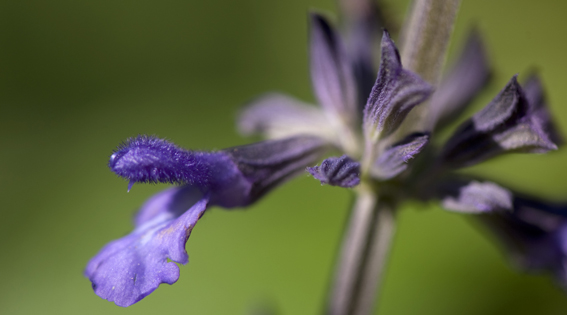Sultry Salvias
Posted in Gardens and Collections on September 24 2013, by Sonia Uyterhoeven
Sonia Uyterhoeven is the NYBG‘s Gardener for Public Education.

Autumn is often an under-appreciated season in the garden. Natural light casts deep shadows and illuminates the garden with silvery hues. Fall foliage adds fire to the drama. While many flowers are fading, statuesque tropical salvias are coming into their own.
In the Perennial Garden, the main entrance is lined with some magnificent salvias. The prominent star of the promenade is the Mexican sage, Salvia ‘Phyllis’ Fancy’, which differs from the straight species in that she flowers earlier and for longer. Her foliage is greener as opposed to the wooly silver tinge of the species.
What she has in common with her predecessors is her beauty. The flowers are the classic velvety purple and white flowers of the Mexican sage. They remind me of pipe cleaners in their texture and appearance. Her most outstanding feature is that she is a hummingbird magnet. Whenever I frequent the location—morning is the best time—I see hummingbirds flitting around the blossoms with their iridescent bodies traveling at the speed of light.
The same location is home to the velvet sage (Salvia confertiflora) whose fuzzy red inflorescences are as soft as the name advertises. She is accompanied by Salvia ‘Blue Chiquita’—a compact salvia with quilted leaves and a white underside. The azure flowers are out from late summer until frost.
Around the garden you will see two tropical salvias in abundance. One is ‘Mystic Spires’, a cross from the popular bedding plant Salvia farinacea ‘Victoria’ and Salvia ‘Indigo Spires’. ‘Indigo Spires’ is a tall and graceful plant that bends and waves her way through your border. The bedding salvia, as you can imagine, is all about precision flowering in a compact form. ‘Mystic Spires’ takes the best of both parents: she is graceful, has wonderfully long flowering spikes, yet is well-behaved.
The other popular salvia this year in our garden is Salvia ‘Van Houttei Paul’. This annual salvia has a beautiful purple reddish bloom that flowers non-stop from late June until October. It will often slow down in the heat of the summer, but it runs full steam ahead once the temperatures start to drop in the fall. As with all salvias, the more you deadhead them the more flowers you will get.

Over the past few years we have had some nice surprises in the garden. The pineapple sage (Salvia elegans), the Black and Blue anise sage (Salvia guaranitica ‘Black and Blue’) and the Argentina Skies anise sage (Salvia guaranitica ‘Argentina Skies’) have come back even though they are not meant to be hardy in our zone. They were cut down to the ground in the fall and came up in the spring with the rest of the perennials. These tender perennials are typically used as annuals, but have promise of being short-lived perennials in our borders. ‘Argentina Skies’ has come back three years in a row.
Tropical salvias—many of them hailing from Mexico, Peru, and Brazil—are useful additions in the border. They are planted in May, pinched back once during the month, and then again at the end of June to branch and form a large mass of foliage and flowers. While many of them flower from July until frost, some only flower later in the season, opening up in September just in time for a late season show. Most of them handle part shade as well as sun and they can be extremely drought tolerant once established. Not sold? Did I mention that, because of their fragrant foliage, they are deer and rabbit resistant? If you haven’t tried one of these beauties, they are worth investigating for next season. In the meantime, come for a stroll around our Garden and admire this year’s collection of late season salvias.

